Raevenlord
News Editor
- Joined
- Aug 12, 2016
- Messages
- 3,755 (1.24/day)
- Location
- Portugal
| System Name | The Ryzening |
|---|---|
| Processor | AMD Ryzen 9 5900X |
| Motherboard | MSI X570 MAG TOMAHAWK |
| Cooling | Lian Li Galahad 360mm AIO |
| Memory | 32 GB G.Skill Trident Z F4-3733 (4x 8 GB) |
| Video Card(s) | Gigabyte RTX 3070 Ti |
| Storage | Boot: Transcend MTE220S 2TB, Kintson A2000 1TB, Seagate Firewolf Pro 14 TB |
| Display(s) | Acer Nitro VG270UP (1440p 144 Hz IPS) |
| Case | Lian Li O11DX Dynamic White |
| Audio Device(s) | iFi Audio Zen DAC |
| Power Supply | Seasonic Focus+ 750 W |
| Mouse | Cooler Master Masterkeys Lite L |
| Keyboard | Cooler Master Masterkeys Lite L |
| Software | Windows 10 x64 |
The crew at WCCFTech have just leaked AMD's now annual major software update release (with Catalyst Omega in 2014 and Crimson Edition in 2015). The new 2016 release is apparently dubbed the "Crimson ReLive" release, and these are purported to bring a lot of features and performance improvements across the board for AMD products, as has been historically achieved by AMD with these annual driver releases. This time, there's just one other thing: game recording and streaming through a built-in app.
Since its inception, the Radeon Software division has released 29 drivers of which 8 were WHQL releases, with support and optimizations for over 28 gaming titles, having been downloaded over 85 million times. AMD seems to put newfound interest in consumer satisfaction with their driver releases, considering how a leaked slide mentions that they have achieved a 4.5/5 rating in customer satisfaction in recent times (AMD had already given us at TPU a glimpse of that at the Computex event in Macau, pre-Polaris days, and this seems to be it). AMD is putting much stock in their DX12 performance thanks to features such as asynchronous compute, and the staples of supported platforms and projects. AMD also seems to have a new-found claim towards it being one of the most important players in the graphics industry, chalking up their market dominance by including gaming consoles in their portfolio.
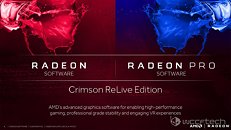
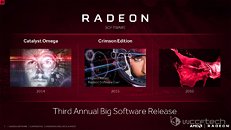

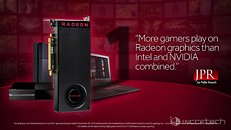
AMD is banking on its open-software approach to cater to developer interest, and is either introducing or updating a myriad of technologies in their new software release. new features include a stitching platform, aptly called Radeon Loom, which allows you to stitch up to 360º photos at an up to 8K x 4K mode, Open Capture and Analytics Tool (OCAT) for benchmarking (with support for DX11, DX12 and Vulkan), a Depth of Field focus tool with low performance impact for DX12, Tress FX 4.0 and support for Advanced Media Framework 1.4, improving support for the H265 format.



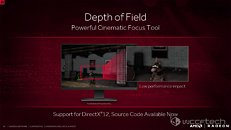
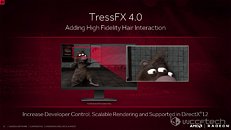
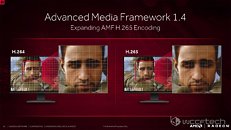
Regarding VR, AMD is improving their Liquid VR approach, by allowing Multi-GPU affinity to take place so as to improve performance up to 20x versus a single graphics adapter (uh), multi-view rendering for lower processing overhead, and MultiRes Rendering (equivalent to NVIDIA's Multi-Res Shading seen i Shadow Warrior 2), as well as support for TrueAudio Next in Liquid VR environments, with dynamically-derived real-times physics being embedded on sound calculations, for truly immersive surround sounds.
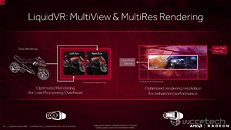

On the performance side, Radeon cards such as the RX 480 see an up to 8% performance increase with ReLive - compared to software version 16.9.2. AMD is touting newfound commitment to quality assurance, performance, features and stability, with overall 25% more QA being done than ever before.
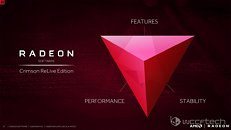
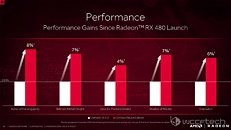
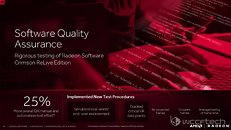
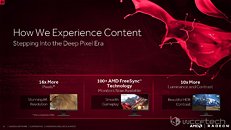
AMD highlights that we are entering an era of "deep pixels", with gamers shifting to 8K resolution monitors with HDR and FreeSync support. AMD is also adding a signal detection utility in their drivers which allows users to detect bad HDMI cable and signals for diagnostics. There's a new VP9 Decode acceleration offering seamless and fluid 4K 60 Hz video streaming with support for both Dolby Vision and HDR 10, thus offering increased brightness, contrast and color. Support for the latest DisplayPort HBR3 has been added in the drivers, allowing for single-link 4K 120 Hz, 5K 60 Hz and 8K 30 Hz rates. FreeSync is seeing some improvements, with up to 24% lower click-to-response time on borderless full-screen mode.





AMD is investing in the driver suite, with apparently improved looks and a streamlined interface, as well as clean install support (yay), an upgrade advisor, and the addition of a "user feedback" interface which will allow users to vote on new features and priority of issues to be fixed.


One of the new features included with Crimson Relive, and one of the most potentially game-changing, is Radeon Chill. This is a new power saving feature that dynamically regulates frame-rate based on in-game movement. In tests, the Radeon Chill features up to 31% lower average GPU power, while also reducing temperatures and, as a result, improving efficiency, with one of the scenarios being tested having been World of Warcraft.

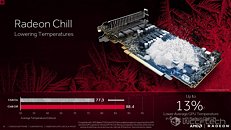
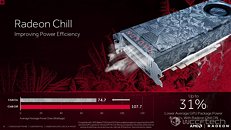

Radeon Chill has the potential to decrease the amount of input-to-response lag compared to a system running without Radeon Chill. By not running the game loop as fast as possible at all times, Radeon Chill doesn't keep the GPU's queues as full. When Radeon Chill does decide to dispatch a frame, the GPU can be ready and waiting to produce that frame very quickly, with little or no work scheduled ahead of it. As a result, Radeon Chill can sometimes reduce input lag. In one example taken from World of Warcraft, the FPS average is measurably higher with Radeon Chill turned off, at 125 FPS, versus 62 FPS with Radeon Chill enabled. In spite of that, the time to display each frame with Radeon Chill enabled (as measured with PresentMon or OCAT) is actually lower for the reasons described above. In cases with the most potential for lag, at the 99th percentile, the system with Radeon Chill enabled delivers frames in substantially less time than the system without Radeon Chill. Radeon Chill will initially work with a list of whitelisted games - apparently, they're manually selected so as to guarantee compatibility, with games such as Deus Ex: mankind Divided, The Witcher 3 and Dark Souls 3 being supported at the time of the software release.
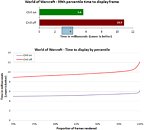
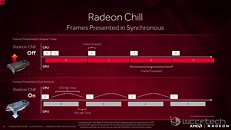
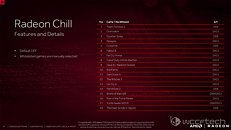
Radeon ReLive apparently takes its name from a new application embedded with the AMD driver suite. Dubbed ReLive, it serves as a streaming app that works for both professional, developer and consumer use cases. It supports major streaming giants (such as Twitch and YouTube), includes an in-app toolbar and custom overlay, and is apparently going to feature its own tab inside AMD's updated driver suite.
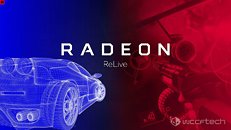
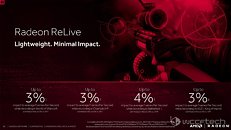
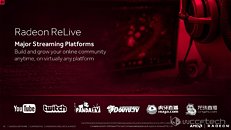
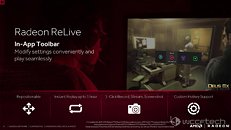
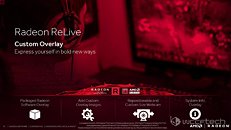
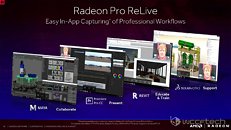
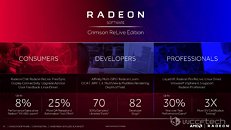
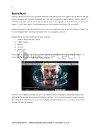
Last, but not least, when it comes to the consumer side of things, AMD announced further Wattman support for even more products, now including the Radeon 200 series, Radeon 300 series and Radeon Fury series products that are listed in the slide below.
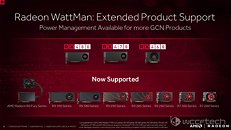
WCCFTech reports that the AMD Crimson Relive Edition will be officially available on 8th December at 9 A.M EST. Let's just wait and see, but if true, this does mark an even more forceful push from the red team into the software side of the equation, where the red company was usually seen as being inferior to its green counterpart. Let's hope this is just another turn of the wheel for the Radeon Technologies Group, and not a mere hot-air balloon.
View at TechPowerUp Main Site
Since its inception, the Radeon Software division has released 29 drivers of which 8 were WHQL releases, with support and optimizations for over 28 gaming titles, having been downloaded over 85 million times. AMD seems to put newfound interest in consumer satisfaction with their driver releases, considering how a leaked slide mentions that they have achieved a 4.5/5 rating in customer satisfaction in recent times (AMD had already given us at TPU a glimpse of that at the Computex event in Macau, pre-Polaris days, and this seems to be it). AMD is putting much stock in their DX12 performance thanks to features such as asynchronous compute, and the staples of supported platforms and projects. AMD also seems to have a new-found claim towards it being one of the most important players in the graphics industry, chalking up their market dominance by including gaming consoles in their portfolio.




AMD is banking on its open-software approach to cater to developer interest, and is either introducing or updating a myriad of technologies in their new software release. new features include a stitching platform, aptly called Radeon Loom, which allows you to stitch up to 360º photos at an up to 8K x 4K mode, Open Capture and Analytics Tool (OCAT) for benchmarking (with support for DX11, DX12 and Vulkan), a Depth of Field focus tool with low performance impact for DX12, Tress FX 4.0 and support for Advanced Media Framework 1.4, improving support for the H265 format.






Regarding VR, AMD is improving their Liquid VR approach, by allowing Multi-GPU affinity to take place so as to improve performance up to 20x versus a single graphics adapter (uh), multi-view rendering for lower processing overhead, and MultiRes Rendering (equivalent to NVIDIA's Multi-Res Shading seen i Shadow Warrior 2), as well as support for TrueAudio Next in Liquid VR environments, with dynamically-derived real-times physics being embedded on sound calculations, for truly immersive surround sounds.


On the performance side, Radeon cards such as the RX 480 see an up to 8% performance increase with ReLive - compared to software version 16.9.2. AMD is touting newfound commitment to quality assurance, performance, features and stability, with overall 25% more QA being done than ever before.




AMD highlights that we are entering an era of "deep pixels", with gamers shifting to 8K resolution monitors with HDR and FreeSync support. AMD is also adding a signal detection utility in their drivers which allows users to detect bad HDMI cable and signals for diagnostics. There's a new VP9 Decode acceleration offering seamless and fluid 4K 60 Hz video streaming with support for both Dolby Vision and HDR 10, thus offering increased brightness, contrast and color. Support for the latest DisplayPort HBR3 has been added in the drivers, allowing for single-link 4K 120 Hz, 5K 60 Hz and 8K 30 Hz rates. FreeSync is seeing some improvements, with up to 24% lower click-to-response time on borderless full-screen mode.





AMD is investing in the driver suite, with apparently improved looks and a streamlined interface, as well as clean install support (yay), an upgrade advisor, and the addition of a "user feedback" interface which will allow users to vote on new features and priority of issues to be fixed.


One of the new features included with Crimson Relive, and one of the most potentially game-changing, is Radeon Chill. This is a new power saving feature that dynamically regulates frame-rate based on in-game movement. In tests, the Radeon Chill features up to 31% lower average GPU power, while also reducing temperatures and, as a result, improving efficiency, with one of the scenarios being tested having been World of Warcraft.




Radeon Chill has the potential to decrease the amount of input-to-response lag compared to a system running without Radeon Chill. By not running the game loop as fast as possible at all times, Radeon Chill doesn't keep the GPU's queues as full. When Radeon Chill does decide to dispatch a frame, the GPU can be ready and waiting to produce that frame very quickly, with little or no work scheduled ahead of it. As a result, Radeon Chill can sometimes reduce input lag. In one example taken from World of Warcraft, the FPS average is measurably higher with Radeon Chill turned off, at 125 FPS, versus 62 FPS with Radeon Chill enabled. In spite of that, the time to display each frame with Radeon Chill enabled (as measured with PresentMon or OCAT) is actually lower for the reasons described above. In cases with the most potential for lag, at the 99th percentile, the system with Radeon Chill enabled delivers frames in substantially less time than the system without Radeon Chill. Radeon Chill will initially work with a list of whitelisted games - apparently, they're manually selected so as to guarantee compatibility, with games such as Deus Ex: mankind Divided, The Witcher 3 and Dark Souls 3 being supported at the time of the software release.



Radeon ReLive apparently takes its name from a new application embedded with the AMD driver suite. Dubbed ReLive, it serves as a streaming app that works for both professional, developer and consumer use cases. It supports major streaming giants (such as Twitch and YouTube), includes an in-app toolbar and custom overlay, and is apparently going to feature its own tab inside AMD's updated driver suite.








Last, but not least, when it comes to the consumer side of things, AMD announced further Wattman support for even more products, now including the Radeon 200 series, Radeon 300 series and Radeon Fury series products that are listed in the slide below.

WCCFTech reports that the AMD Crimson Relive Edition will be officially available on 8th December at 9 A.M EST. Let's just wait and see, but if true, this does mark an even more forceful push from the red team into the software side of the equation, where the red company was usually seen as being inferior to its green counterpart. Let's hope this is just another turn of the wheel for the Radeon Technologies Group, and not a mere hot-air balloon.
View at TechPowerUp Main Site
Last edited by a moderator:





 I'm sick of being capped at 72 fps and can't afford a freesync monitor till sometime next year
I'm sick of being capped at 72 fps and can't afford a freesync monitor till sometime next year



